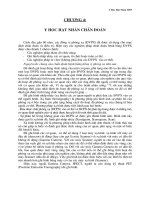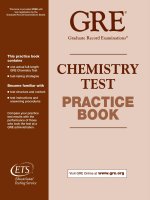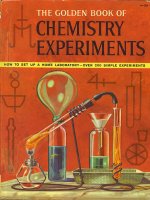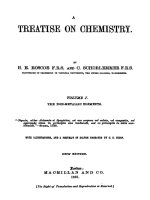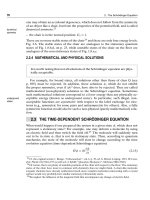Chemistry 4: Organic Chemistry 1 doc
Bạn đang xem bản rút gọn của tài liệu. Xem và tải ngay bản đầy đủ của tài liệu tại đây (1.43 MB, 81 trang )
Organic Chemistry 1
Dr. George Mhehe and Mahamud M. Korane
African Virtual university
Université Virtuelle Africaine
Universidade Virtual Africana
Chemistry 4
African Virtual University 1
Notice
This document is published under the conditions of the Creative Commons
Attribution
License (abbreviated “cc-by”), Version 2.5.
African Virtual University 2
I. Chemistry 4, Organic Chemistry 1 _____________________________ 3
II. Prerequisite Course or Knowledge _____________________________4
III. Time ____________________________________________________ 4
IV. Materials _________________________________________________4
V.
Module Rationale __________________________________________
5
VI. Content __________________________________________________ 5
6.1 Overview ____________________________________________ 5
6.2 Outline _____________________________________________6
6.3 Graphic
organizer _____________________________________7
VII. General Objective(s) ________________________________________
8
VIII. Specific Learning
Objectives __________________________________8
IX Pre-assesment ___________________________________________ 10
X. Key Concepts
(Glossary) ____________________________________ 13
XI. Compulsory Readings ______________________________________
16
XII. Compulsory Resources _____________________________________
20
XIII. Useful Links _____________________________________________
21
XIV. Learning Activities _________________________________________
60
XV. Synthesis of
the Module ____________________________________ 74
XVI. Summative Evaluation ______________________________________
75
XVII. References ______________________________________________79
XVIII. Main
Author of the module _________________________________80
African Virtual University 3
Prepared by Dr. George L. Mhehe and Mahamud Mohamed Korane
Aliphatic Organic compounds and their interrelated functional groups
With all single bonds
With
double bonds
With
Triple bonds
Aliphatic
Hydrocarbons
Alkanes
Akenes
Alkynes
Cycloalkanes
African Virtual University 4
Chemistry I Course: Atomic structure and Bonging, and Chemical reactions
And Chemistry II Course: Chemicaal Kinetics, Thermodynamics and solution
Chemistry
Chemistry I course is a general introductory chemistry course, it has important
aspects that are needed to undestand the organic chemistry in this module. The
knowledge on bonding, the difference between ionic and covalent bonding,
electronic conguration of different atoms; all these aspects are vital for a good
understanding of this module on organic chemistry . Chemistry II course is even
a more relevant prerequisite for this module because it had a unit on introductory
organic chemistry where at the end of that particular unit of that module you
were expected to be able to
• classify types of organic compounds based on functional groups
• name different classes of organic compounds using the International Union
of Pure and Applied Chemistry (IUPAC) system of nomenclature
• write structural formulas of different isomeric compounds
• relate properties and reactions of organic compounds to functional
groups.
To cover this model will require about 120 hours distributed as follows
Unit I: 20 hrs
Unit II: 20 hrs
Unit III: 20 hrs
Unit IV: 20hrs
Unit V: 20hrs
Unit VI: 20hrs
The following Tools and resources are important materials that will be necessary
to learn this module:
Models of structures of Aliphatic hydrocarns on CD-ROMs
Internet-based as a references of the learners
Computer aided instruction (CAI)
Computer-based assessment (CBA)
African Virtual University 5
Multimedia delivery (including video conferencing)
e-Library and data base utilization
Integrated learning environment
Interactive discussions/chat sessions
Recommended textbooks and reference(including web pages) materials
This module in organic chemistry is designed to prepare students that wish to
become teachers : Student teachers must have knowledge of the key concepts
and classication tools of organic chemistry that include functional groups of
hydrocarbons,alcohols and ethers,aldehydes and ketones,alkyl halides,carboxycylic
acids and their derivatives and amines.Classes of organic compounds can be dis-
tinguished according to functional groups they contain.
Organic compounds are now dened as compounds that are based on carbon. So
the branch of chemistry that deals with carbon compounds is organic chemistry.
They usually contain carbon-carbon and carbon hydrogen bonds.
Carbon`s unique bonding properties allow the formation of a variety of structures,
including chains and rings of many shapes and sizes.
6.1 Overview
This module is the branch of chemistry that deals with carbon compounds and it is called
organic chemistry.
This module is about classes of organic compounds that can be distinguished according
to functional groups they contain.
In this module you will be learning the characteristic properties of a number of functio-
nal groups. Thus by studying the characteristic properties of a few of these functional
groups,you will be able to understand the properties of many organic compounds.
African Virtual University 6
In this module we will have functional groups of hydrocarbons,alcohols and
ethers,aldehydes and ketones, alkyl halides,carbocyclic acids and their derivatives, and
amines.
6.2 Outline
The following is the outline of the content of this module.
Unit I –Hydrocarbons
Aliphatic hydrocarbons
Physical and Chemical properties of hydrocarbons.
Unit II-Alcohols and Ethers
Chemistry of the functional group.
physical and chemical properties and reactions of alcohols and ethers
Synthesis of alcohols and ethers
Unit III -Aldehydes and ketones
The structure of aldehydes and ketones
Physical properties of aldehydes and ketones
Aldehydes and ketones using the IUPAC system of nomenclaure
Typical reactions of aldehydes and ketones
Synthesis of aldehyde and ketones
Unit IV -Alkly halides
The different categories of alkly halides
Nomenclature of alkly halides using the IUPAC system
Physical and Chemical properties of alkyl halides
Typical reactions of alkly halides
Preparation of alkly halides
Unit V-Carboxylic acids and their deivatives
Structure of carboxylic acids and their derivatives
IUPAC nomenclature carboxylic acidsof and their derivatives
Unit VI -Amines
Different categories of amines
The general structure of amines
Naming amines using the IUPAC nomenclature
African Virtual University 7
6.3 Graphic Organizer
RCH
O
RCR'
O
C
R
R
C
R
R
RCO
2
H
RX
RCONHR
RC-O-CHR
OO
RCX
O
ALCOHOLS
ROR'
Ethers
Aldehdes
Ketones
Alkenes
Carboxylic acids
RCO2R'
Esters
Alkyl halides
Amides
(via RO
2
H)
Acid anhydrides
(via RO
2
H)
Acyl halides
(via RO
2
H)
THE CENTRAL POSITION OF ALCOHOLS IN ORGANIC CHEMISTRY
Alcohols can be prepared from, and converted into many other kinds of compounds
Hydrocarbons
Aliphatic
Aromatic
Alkanes cycloalkanes Alkenes Alkynes
African Virtual University 8
Aquire the vocabulary and basic theories of modern organic chemistry
• to familiarise you with the concept of aliphaticity and aliphatic com-
pounds so that you are able to identify aliphatic compounds based on
their structures.
• To understand the different types of aliphatic compounds and know how
to name them using the IUPAC system of nomenclature
• Investigating and solving problems
• to help you to use ICT facilities in teaching
Unit Learning objective(s)
Unit I.Hydrocarbons Differentiate among the different types of hydrocar-
bons
Name saturated and unsaturated hydrocarbons
Descibe and predict typical reactions of hydrocar-
bons
Describe the physical and chemical properties of
hydrocarbons
Unit II .Alcohols and Ethers Differentiate among the various categories of alco-
hols
Name alcohols and ethers
Describe and predict typical reactions of alcohols
and ethers
Describe the physical and chemical properties of
alcohols and ethers
Describe the synthesis of alcohols and ethers
Unit III.Aldehydes and ketones Differentiate between the structures of aldehydes
and ketones
Differentiate between the physical and chemical
properties of aldehydes and ketones
Name aldehydes and ketones by using IUPAC
nomenclature system
Describe and predict typical reactions of
aldehydes and ketones
Describe the synthesis of aldehydes and ketones
African Virtual University 9
Unit IV.Alkly halides Diff
erentiate among the different categories of alkyl
halides
Name the alkly halides by using IUPAC system
Describe the physical and chemical properties of
alkyl halides describe and predict typical reactions
of alkyl halides
Give the different methods of preparation of alkyl
halides
Unit V. carboxylic Identify the general structure of caboxylic acids and
acids and derivatives their derivatives
Name the carboxylic acids and their deravatives
using IUPAC system
Describe the properties and chemical reactions of
carboxylic acids and their derivatives
Describe the various methods of preparations of
carboxylic acids and their derivatives
Unit VI. Amines Identify the various categories of amines
Identify the general structure of amines
Name amines by using IUPAC system
Describe the properties and chemical reactions of
amines
Describe the various methods of preparations of
amines
African Virtual University 10
Title of Pre-assessment :
Multiple choice questions to test your understanding of the concepts covered in
the module
Rationale :Answering these questions effectively will be a good indication of
your grasp of the subject matter covered in this module
Questions
Circle the correct answer
1. Hydrocarbons contain
A-Hydrogen and Chlorine only
B-Hydrogen and Carbon only
C-oxygen and carbon only
2. The main classes of Hydrocarbons are
A- Aliphatic and ketone
B-alkane and alkenes
C-aliphatic and aromatic
3. The general formula of Alkanes is
A-C
n
H
2n+2
B- CnH
2n+1
C-C
n
H
2n
4. The general formula of Alkenes is
A- C
nH2n+1
B- C
n
H
2n+2
C-C
n
H
2n
5. THe name 2-Ethylhexane is incorrect because
A-This is a common name rather than an IUPAC name
B-The longest chain has seven carbons rather than six carbons
C-Both answers A and B are correct
African Virtual University 11
6. The general formula of Alkynes is
A- C
n
H
2n+1
B- C
n
H
2n
C- C
n
H
2n-2
7. The simplest alkyne is
A-methane
B-Acetylene
C-butene
8. Aromatic hydrocarbons contain
A-one or more Benzene rings
B-one or more carbon-oxygen chains
C-none of them
9. All alcohols contain
A-halogen groups
B-Benzene group
C-hydroxyl group
10. The difference between aldehydes and ketones is
A. Aldehydes have oxygen
as one of the atoms in their molecules but not
ketones
B. Ketones have carbon-oxygen double bond but not aldehydes
C. none of the above
11.For
the following compounds: Carboxylic acids, alcohols, and aldehydes, the
most polar compond are
A - Aldehydes
B -carboxylic acids
C -alcohols
12. Amines are realated to
A-organic acids
B-Ammonia
C-none of the above
African Virtual University 12
13. When isomeric butenes are hydrogenated
A - All of them give the same saturated hydrocarbon product
B Some give the same saturated hydrocarbon product
C None of the answers above is correct
14.When the terms primary, secondary and tertiary are applied to amines their
meanings are not the same because
A alcohols are non-basic while amines are basic
B
The classication in alcohols is based on the number of alkyl groups attached
to the carbon carrying the OH group while in amines this is not based on
the number of alky groups to which the amino group is attached
C None of the above is correct
ANSWER KEY
1. B
2. C
3. A
4. C
5. B
6. C
7. B
8. A
9. C
10. C
11. B
12. B
13. B
14. B
5 marks X 14 = 70 marks
Notes to the student:
If you get 6 items or more correct you can consider that you are doing ne, but
if you get less than 4 items correct then you have to work very hard to pass the
course.
African Virtual University 13
1. Hydrocarbons are the simplest organic compounds that contain carbon and
hydrogen only. They may be gaseous, liquid or solids. They can be straight-
chain, branched chain, or cyclic molecules. Carbon tends to form four bonds
in a tetrahedral geometry. Hydrocarbon derivatives are formed when there is
a substitution of a functional group at one or more of these positions.
For example
CH
3
CH
3
Ethane
Examples of derivatives of ethanes are
CH
3
CH
2
OH and CH
3
CH
2
Cl
Ethanol
Ethyl chloride
2. Aliphatic hydrocarbons contain carbon atoms that are bonded in one or more
chains and rings. The carbon atoms have single, double and triple bonds.
Aliphatic hydrocarbons include straight chain and cyclic alkanes, alkenes
and alkynes
3. An alkane is
a hydrocarbon that has only single bonds. Alkanes that do not
contain rings have he formula C
nH2n+2. An alkane in the shape of a ring is
called a cycloalkane. Cycloalkanes have the formula CnH2n.
4. An alkene is a compound that has at least one double bond. A straight-chain
alkene with one double bond has the formula C
nH2n. The functional group
for an alkene is the double bond.
5. An alkyne is a compound that has at least one triple bond. A straight-chain
alkyne with one triple bond has the formula C
nH2n-2. Triple bonds are even
more reactive than double bonds. The functional group for an alkyne is the
triple bond.
6. Alcohols : These are organic compounds that contain the hydroxyl (-OH)
group as their functional group.
Dep
ending on the position of the hydroxyl group, An alcohol can be an
primary,secondary or tertiary.
Alcohols are organic compounds containing a hydroxyl group, -OH, substituted
for a hydrogen atom. The names of alcohols start with the name of the alkane but
end with the sufx -ol, like the simplest alcohol, methanol.
methanol
African Virtual University 14
Ethanol is the alcohol in alcoholic beverages and it is also widely used as a
solvent.
ethanol
Alcohols can have more than one hydroxyl group. Ethylene glycol, used as an-
tifreeze in automobiles has two OH groups.
7. Ether : is an organic compunds that has two alkyl groups joined by an oxygen
atom. The general formula of an ether is R-O-R
8. Car
bonyl group: is composed of carbon atoms double bonded to an oxygen
C=O
9. Aldehydes: is an organic compond that has double bonded xygen on the
last
O
II
cabon of a carbon chain the funcional group of an aldehyde is CH the general
formula for an aldehyde is R-CHO, R- is any alkyl group.
10.Ketone: is an organic compound that has a double-bonded oxygen on any
O
II
carbon with the carbon chain. The functional group of ketone is – C –
1
1. Alkyl halides:
an alkane in which one or more hydrogen atoms have been
replaced with halogen atoms
12. Aliphatic compounds: These are open chain compounds and those cyclic
compounds that resemble open chain compounds
13. Aromatic compounds: These are are benzene and compounds that resemble
benzene in their chemical behaviour
14. Heterocyclic compounds: These are cyclic compounds in which one or more
atoms in the cyclic structure is other than carbon. Heterocyclic componds
may be aliphatic or aromatic
African Virtual University 15
15. Isomers: These are different compounds that have the same molecular formula.
Isomers are further subdivided into:
(a) structural isomers,
(b) geometrical isomers and
(c) stereoisomers(optical isomers)
16. A functional
group of a compound: This is the atom or group of atoms that
denes the structure of a particular family of organic compounds and at the
same time determines their properties
The simplest common alkyl halides are chloroform and carbon tetrachloride.
Chloroform was used as a medical anesthetic in the past, but has been found to
be carcinogenic. Carbon tetrachloride also has a long history of use in re ex-
tinguishers, as a fabric cleaner, and as a solvent, but it causes liver damage and
now is used much less.
An important class of alkyl halides is the chlorouorocarbons (CFCs) which have
been used in air conditioners, etc., as refrigerants. They face sharply curtailed use
now because of danger to the ozone layer.
O
II
17.
Carboxylic acid :is
an oganic cmpound with the following functional groups
–C-OH this –COOH group is called the carboxylic group. The general formula
for carbocxylic acids is R-COOH
18. Amines: an or
ganic compound with the functional group –NH
2, -NHR, or
NR2 is called an amine.
The letter N refers to the nitrogen atom. The letter R refers to an alkyl group
attached to the nitrogen. The general formula of an amine is R-RN`
2.
African Virtual University 16
Reading #1
Complete reference: Alcohols- From Wikipedia, the free encyclopedia
/>Abstract :The article discusses the structure of alcohol as a derivative of of water
with one of the hydrogens replaced by an alkyl group. Athe functionalgroup of
alcohol is OH group.The article also gives classication of alcohols into primary,
secondary and tertiary alcohols. The simplest and most commonly used alcohols
are methanol (methyl alcohol) and ethanol (ethyl alcohol. IUPAC nomenclature
of alcohols is also discussed. Reactions of alcohols are also discussed including
diprotonation using sodium metal, nucleophilic substitution via the protonated
alcohol, dehydration to give alkenes, esterication and oxidation to give aldehy-
des, carboxylic acids and ketones
Rationale: This ia anine page article which introduces the chemistry of alcohols
very well. At the end of the article there are further links to direct the student to
further readings.
Aldehyde- From Wikipedia, the free encyclopedia
/>Abstract: An aldehyde is an organic compound containing a terminal carbonyl
group, i.e., a O=CH- group attached to hydrogen or a carbon chain. This functional
group, which consists of a carbon atom which is bonded to a hydrogen atom and
double-bonded to an oxygen atom (chemical formula -CHO), is called the alde-
hyde group. The aldehyde group is also called the formyl or methanyl group.
The word aldehyde seems to have arisen from alcohol dehydrogenated. In the
past, aldehydes were sometimes named after the corresponding alcohols, for
example vinous aldehyde for acetaldehyde. (Vinous is from Latin vinum = wine,
the traditional source of ethanol; compare vinyl.)
The aldehyde group is polar. Oxygen, being more electronegative, pulls the
electrons in the carbon-oxygen bond towards itself, thus creating an electron
deciency at the carbon atom.
Owing to resonance stabilization of the conjugate base, an α-hydrogen in an
aldehyde is more acidic than a hydrogen atom in an alkane, with a typical pKa
of 17.
IUPAC names for aldehydes
IUPAC prescribes the following nomenclature for aldehydes:
African Virtual University 17
1. Acyclic aliphatic aldehydes are named as derivatives of the longest carbon
chain containing the aldehyde group. Thus, HCHO is named as a derivative
of methane, and CH
3
CH
2
CH
2
CHO is named as a derivative of butane. The
name is formed by changing the sufx -e of the parent alkane to -al, so that
HCHO is named methanal, and CH
3
CH
2
CH
2
CHO is named butanal.
2. In other cases, such as when a -CHO group is attached to a ring, the sufx
-carbaldehyde may be used. Thus, C
6
H
11
CHO is known as cyclohexanecar-
baldehyde.
3. If another functional group is present which IUPAC rules prescribe must be
named as a sufx, the aldehyde group is named with the prex formyl This
prex is preferred to methanoyl Aldehydes are also commonly recognised
as alkanals, for example, methanal and ethanal are the basic aldehydes.
Rationale: The chemistry of aldehydes (and ketones) is very rich. The students
is well introduced to this chemistry in this article
Ketone- From Wikipedia, the free encyclopedia
/>Abstract:A ketone is either the functional group characterized by a carbonyl group
(O=C) linked to two other carbon atoms or a chemical compound that contains
this functional group. A ketone can be generally represented by the formula:
R
1
(CO)R
2
.
A carbonyl carbon bonded to two carbon atoms distinguishes ketones from car-
boxylic acids, aldehydes, esters, amides, and other oxygen-containing compounds.
The double-bond of the carbonyl group distinguishes ketones from alcohols and
ethers. The simplest ketone is acetone (also called propanone).
The carbon atom adjacent to a carbonyl group is called the α-carbon. Hydrogens
attached to this carbon are called α-hydrogens. In the presence of an acid catalyst
the ketone is subjected to so-called keto-enol tautomerism. The reaction with a
strong base gives the corresponding enolate. A diketone is a compound containing
two ketone groups.
Rationale: The chemistry of ketones (and aldehydes) is very rich. The students
is well introduced to this chemistry in this article
African Virtual University 18
Reading #2
Complete reference : Amine-From Wikipedia, the free encyclopedia
/>Abstract: Aliphatic Amines
As displayed in the images below, primary amines arise when one of three
hydrogen atoms in ammonia is replaced by an organic substituent. Secondary
amines have two organic substituents bound to N together with one H. In tertiary
amines all three hydrogen atoms are replaced by organic substituents. Note: the
subscripts on the R groups are simply used to differentiate the organic substituents
. However, the number subscripts on the H atoms show how many H atoms there
are in that group. It is also possible to have four alkyl substituents on the nitrogen.
These compounds have a charged nitrogen center, and necessarily come with a
negative counterion, so they are called quaternary ammonium salts.
Primary amine Secondary amine Tertiary amine
Aromatic amines
Main article: Aromatic amines
Aromatic amines have the nitrogen atom connected to an aromatic ring as in
anilines. The aromatic ring strongly decreases the basicity of the amine, depen-
ding on its substituents. Interestingly, the presence of an amine group strongly
increases the reactivity of the aromatic ring, due to an electron-donating affect.
One organic reaction involving aromatic amines is the Goldberg reaction
Rationale: Amines are important compounds in the dye industry in the manu-
facture of azo dyes, they are also important in the formation of peptide linkage
in proteins and also in synthetic polymerspolymers
African Virtual University 19
Carboxylic acid- FromWikipedia, the free encyclopedia
/>-
acid
Abstract: Carboxylic acids are organic acids characterized by the presence of a
carboxyl group, which has the formula -(C=O)-OH, usually written as -COOH.
In general, the salts and anions of carboxylic acids are called carboxylates
The simplest series of carboxylic acids are the alkanoic acids, R-COOH, where
R is a hydrogen or an alkyl group. Compounds may also have two or more car-
boxylic acid groups per molecule.
Rationale: Carboxylic acids are a group of compounds of great importance
in fats and oils and also in ester formatiom in synthetic polymer chemistry. It
is important that the student understands their chemistry. This article is a good
introduction to the chemistry of carboxylic acids
Reading #3
Complete reference : Ester-From Wikipedia, the free encyclopedia
/>Abstract : This article deals with the chemistry of esters It deals with naming
esters, physical properties, synthesis and reactions of esters. At the end there
are also external links which discuss interesting aspects of esters including their
avours like that of ripe banana. This is an interesting article for the student to
learn the importance of sters in life.
Rationale: This article will expose the student to interesting chemistry of esters
and thus learn important reaction like the dieckmann condensation. The different
search engines will expose the student to a lot of chemistry on esters, carboxylic
acids and alcohols and their reactions
African Virtual University 20
Resource #1
Complete reference :Refer to the File Korane (Organic I)
Abstract : the links and the books above details about the aliphatic hyrdocarbons
Rationale: Organic chemistry is the chemistry of compounds which contain
carbon - which is a vast number of compounds. Carbon forms more compounds
than any other element except hydrogen.
Resource #2
Complete reference :
Abstract : the links and the books above details about the aliphatic hyrdocarbons
Rationale: Organic chemistry is the chemistry of compounds which contain
carbon -which is a vast number of compounds. Carbon forms more compounds
than any other element except hydrogen.
African Virtual University 21
Useful Link #1
Title: Understanding chemistry: Properties of organic compounds menu
URL: http:www.chemguide.co.uk/orgpropsmenu.html
Screen Capture
Description : Properties of organic compounds menu deals with properties of
alkanes, alkenes, haloalkanes (alkyl halides, alcohols, aldehydes and ketones,
carboxylic acids, esters, acid anhydrides acyl halides in short It deals with aliphatic
aromatic compounds under the different topics. Folloeup of the topics will expose
the student to the chemistry of the different functional groups
Rationale: this menu will give a hint to the student about the different topics to
be covered.
African Virtual University 22
Useful link # 2
Title: Understanding chemistry: halogenoalkanesmenu
URL: />Screen Capture
Description: An introduction to the halogenoalkanes, their reactivity and their
physical properties.
Making halogenoalkanes . . . Making halogenoalkanes in the lab from alco-
hols.
Reactions with hydroxide ions:
The reaction with hydroxide ions from, for example, sodium hydroxide solu-
tion leading to substitution and elimination reactions.
The reaction with cyanide ions . . .
The reaction with cyanide ions from, for example, a solution of potassium cya-
nide in alcohol.
The reaction with ammonia . . .
The reaction with ammonia to produce various kinds of amines.
Reactions involving silver nitrate solution . . .
Includes testing for halogenoalkanes, and the use of silver nitrate solution as a
guide to the reactivity of the various halogenoalkanes.
Grignard reagents . . .
An introduction to Grignard reagents, including making them from halogenoal-
kanes and some of their simple reactions.
African Virtual University 23
Uses of halogenoalkanes . . .
Including the problems associated with CFCs.
Rationale : This clearly outlines all that is needed to be covered under alkyl
halides. Chemistry of alkyl halides is rich as shown by the type of reaction they
undergo and the products obtained. It is important that one gets good understan-
ding of this topic
Useful Links # 3
Title: Organic bonding menu
URL: />Screen Capture
Description: Electronic structure and orbitals . . .
An introduction to the arrangement of electrons in atoms - leading to the modern
electronic structures of carbon and hydrogen.
Bonding in methane . . .
Covers bonding in methane and ethane, including a simple look at hybridisa-
tion.
Bonding in ethene . . .
Covers bonding in ethene, including a simple look at hybridisation.
Bonding in ethyne (acetylene). . .
Looks at the formation of a carbon-carbon triple bond. (If you aren’t happy about
bonding in ethene, read that rst!)
African Virtual University 24
Rationale : Going through this article will expose the student to the concept of
bonding in the different aliphatic aromatic compouds to understand well this
aspect of chemistry
Useful link # 4
Title: Electronic structure and atomic orbitals
URL: />Screen Capture
Description: A simple view
In any introductory chemistry course you will have come across the electronic
structures of hydrogen and carbon drawn as:
The circles show energy levels - representing increasing distances from the nu-
cleus. You could straighten the circles out and draw the electronic structure as a
simple energy diagram.
